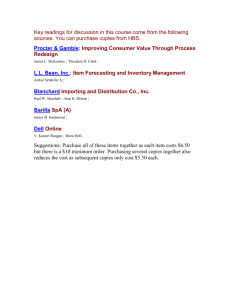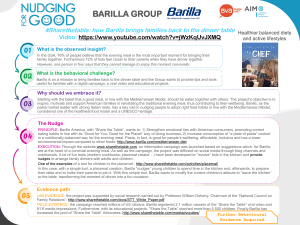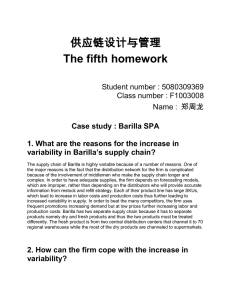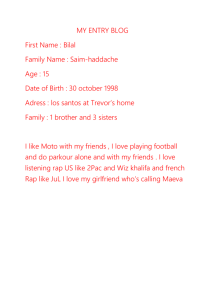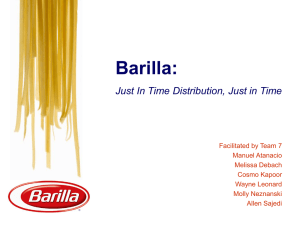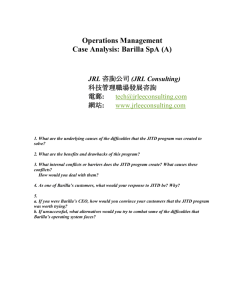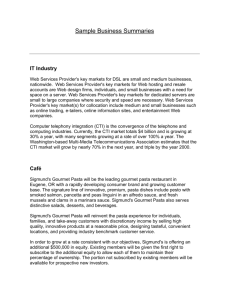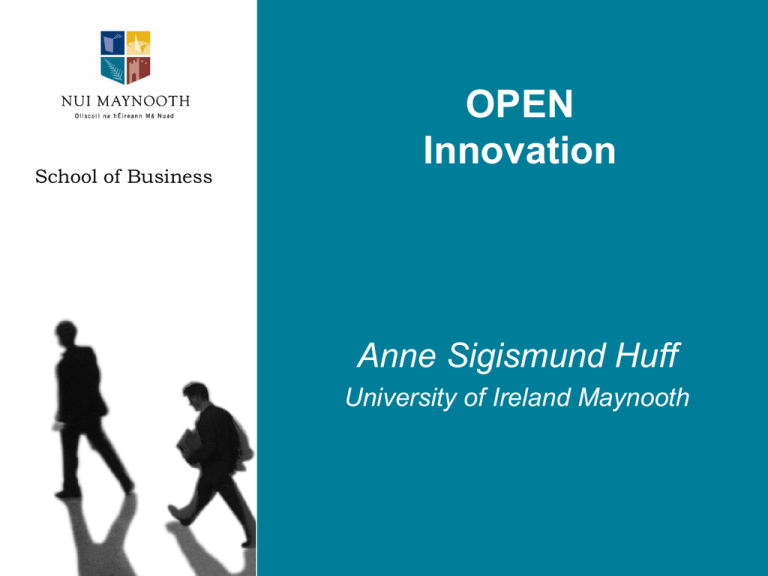
School of Business
OPEN
Innovation
Anne Sigismund Huff
University of Ireland Maynooth
AGENDA
Define Innovation
Sources of innovation
Three interesting trends
• Open innovation
• User and customer innovation
• Service innovation
Management’s contribution to
• Disruptive Innovation
• Incremental Innovation
SCHOOL OF BUSINESS
2
School of Business
What is an innovation?
Why is it important?
Invention*
….
2. U.S. Patent Law . a new, useful process,
machine, improvement, etc., that did not exist
previously and that is recognized as the product
of some unique intuition or genius, as
distinguished from ordinary mechanical skill or
craftsmanship.
*invention. (n.d.). Dictionary.com Unabridged. Retrieved October 09, 2011, from
Dictionary.com website: http://dictionary.reference.com/browse/invention
SCHOOL OF BUSINESS
4
Innovation*
Although the term is broadly used, innovation
generally refers to the creation of better or
more effective products, processes,
technologies, or ideas that are accepted
by markets…
* http://en.wikipedia.org/wiki/Innovation, accessed Oct. 9, 2011
SCHOOL OF BUSINESS
5
Multiples Levels of Innovation
Network Innovation
Corporate Innovation
Organizational
Innovation
Functional Innovation
Individual Innovation
SCHOOL OF BUSINESS
© Anne Sigismund
6
IT IS NOT EASY TO BRING
SOMETHING NEW TO MARKET
SCHOOL OF BUSINESS
7
SCHOOL OF BUSINESS
8
Of 197 products brought to market
124 immediate failures
54 lose money
17 mediocre results
ONLY 11 successful (11/1919 = .006%)
BIG ISSUE: How to generate enough quality
ideas to reach market success
SCHOOL OF BUSINESS
9
Degree of
Technological Assimilation
2nd big issue -- Diffusion
“The Classic S-Curve”
Time
SCHOOL OF BUSINESS
10
PROBLEM
SOLUTION
HOW I GOT FROM
ONE TO THE OTHER
SCHOOL OF BUSINESS
11
Maturity
Figure 2.3: Thomas Lackner (Siemens)
The Most Important Innovation Strategies and their
Positioning along the Technology Lifecycle*
Basic technologies:
Basic competence
for today‘s business
Fast follower
“The early bird catches the
worm but the second
mouse gets the cheese“
(G. Keillor)
Key technologies:
Determine today‘s
competitiveness
First mover
“The early bird catches
the worm“
Pace-setting technologies:
(American saying)
Determine tomorrow‘s
competitiveness
New technologies:
Discontinuity
New rules of the game
Trendsetter
“If you‘re in control of
wormholes and mousetraps, you get both –
the worms and
the cheese“
Time
*From Huff et al. (forthcoming) Leading Open Innovation. MIT Press.
© Siemens AG. All rights reserved
SCHOOL OF BUSINESS
12
Different Foci of Innovation
Look forward: Invention & Innovation
first mover and fast follower
Look backward: Expand markets, develop products
performance by implementation
Look outside: Suppliers & other stakeholders (those
who care, especially customers – YOU)
Look inside: Products/services/experiences,
processes, structures from those close to delivery
SCHOOL OF BUSINESS
13
3rd issue: disruption of the status quo
Incremental innovation
close to current markets, close to current products
Radical (disruptive) innovation
Farther from current skills and current markets
SCHOOL OF BUSINESS
14
Figure 2.2: Thomas Lackner
Different Paths from Innovation to the Market*
III
iPod - iPhone
MRI
• Easy to use
• Attractive design
I
• New imaging technology
• Other diagnostic possibilities
ICE 1-3
II
LED
Existing
Market
New
IV
• Incremental improvement
• Brighter
• Lower power consumption
Existing
New
Technology
© Siemens AG. All rights reserved
*From Huff et al. (forthcoming) Leading Open Innovation. MIT Press.
SCHOOL OF BUSINESS
15
School of Business
Where do ideas come from?
Who develops them?
YOU are an important innovator
Young
• Energy and enthusiasm
• Less influenced by the past
• Today’s and tomorrow’s consumer
University trained
• Increasingly important cutoff for employment
(and thus consumption)
Helpful frameworks and tools to address new
situations
SCHOOL OF BUSINESS
17
Possible group exercise
SCHOOL OF BUSINESS
1. Hold your mobile phone
2. Think individually of new hardware features
(not available now) that you would like your
phone to have
3. Quickly list these ideas one at a time going
around the group with no comments except
clarifications
4. Encourage new ideas to emerge
5. Each person vote on 3 that you like best
6. Report on winner(s)
18
Why group?
New ideas will come to you as you hear what other are
thinking of
[ A myth that inventions spring fully formed from one person’s mind]
Why strangers?
Innovative solutions often come from varied & unexpected
sources
Why mobile phone?
A product most of you use and care about
Mobile phone hardware and apps still changing
(clear room for innovation)
Why hold your phone?
More ideas in context
SCHOOL OF BUSINESS
19
Why think individually before discussion?
Groups tend to head quickly in one direction
One or two people tend to dominate
“Social loafing” is too easy
Why list all ideas before development or
evaluation?
Basic brainstorming: do not evaluate too soon
Make sure all are involved (otherwise ideas from
high status tend to have too much weight)
Finding from research: best ideas build on others
SCHOOL OF BUSINESS
20
Why vote on three?
Helps separate idea from the proposer
Maintains a large idea pool
(don’t fall in love too soon)
Why report on winners to a larger group?
Again, keep the pool large
Expect further building on ideas from others
Research shows that a winning idea is often
generated late in the innovation process
SCHOOL OF BUSINESS
21
You can train yourself to be a better
innovator
Learn about and use creativity techniques (web)
Analyze new product/services/experiences on the market
• Anticipate innovations
• Predict outcomes
Keep up with the news and think about innovation at
different levels
- Economies
– Governments
- Industries
– Companies
- Public organizations - Individuals
– Groups (e.g. sports enthusiasts)
SCHOOL OF BUSINESS
22
Even more important!
Learn how to work effectively in groups
(inventions often first developed by one, innovation to
market almost always involves many)
Become a student of organizations, especially your
organizations
Continually improve your communication skills
Learn how to make things HAPPEN
• Lean toward action
(ALL GOOD CAREER ADVICE IN GENERAL especially
important in an era that is emphasizing innovation)
SCHOOL OF BUSINESS
23
BUT (as we will discuss) invention and
innovation are not always welcome
SCHOOL OF BUSINESS
24
Disruptive innovators tend to be
‘Wild ducks’ with a divergent point of view
though at the same time success comes especially to
those who are socially connected
Dissatisfied with the status quo
but aware of how it works
Persistent, able to learn from negative experience
Supported by someone who listens and believes
but also challenges
• A partner/friend
• A co-worker
• A leader
SCHOOL OF BUSINESS
25
Not surprisingly, innovations are often resisted
NIH
“not
invented
here”
SCHOOL OF BUSINESS
© Anne Sigismund
26
Figure 4.6: Rudi Gröger
A Small List of Arguments used to Slow the Change Process*
We tried that before
It‘s hopelessly complex
This place is different
You are right, but...
It costs too much
You‘re two years ahead of your time
That‘s beyond our responsibility
We don‘t have the personnel
We‘re all too busy to do that
It isn‘t in the budget
That‘s not my job
It‘s a good thought, but impractical
It‘s too radical a change
Lets give it more thought
We don‘t have the time
Top management would never go for it.
There‘s not enough help
Let‘s put it in writing
Our place is too small for it
We‘d lose money in the long run
It isn‘t practical for operating people
It‘s never been tried before
The folks will never buy it
Let‘s shelve it for the time being
The union will scream
Let‘s form a commitee
We‘ve never done it before
Has anyone else ever tried this?
It‘s against regulations
What are you really saying is...
It runs up overhead
Maybe that will work in your department, but it won‘t in mine
We don‘t have the auhtority
The executive committee will never ...
That‘s too ivory-tower-like
Don‘t you think we should look into that further before we act?
Let‘s get back to reality
Let‘s all sleep on it
That‘s not our problem
It won‘t pay for itself.
Why change it?
I know a fellow who tried this way
It‘s still working okay
What would the president say?
SCHOOL OF BUSINESS
*From Huff et al. (forthcoming) Leading Open Innovation. MIT Press.
27
School of Business
New innovations for
generating innovations?
Three interesting developments
1. Open innovation
• Within the organization
• With selected communities
• Open to an unrestricted audience
User / customer innovation
Service innovation (80% plus of most GNP)
SCHOOL OF BUSINESS
29
Open Innovation to expand the “solution space”
for ideas that can make it to market
“ assumes that firms can and should
use external ideas as well as internal ideas, and
internal and external paths to market…”
Henry Chesbrough, Open Innovation (HBPress 2003)
(http://www.openinnovation.net/)
SCHOOL OF BUSINESS
30
An Example of OI from within an Organization
From Robinson & Stern*
• Japan Railways East (largest rail carrier in the world)
constructing new bullet-train north of Tokyo
– Slowed by water in tunnel through large mountain
– Engineers drew plans to drain away
• Maintenance worker (job = safety of tunnel equipment)
– Noticed that workers were enjoying the water
– Proposed the railroad should bottle and market it as a
premium drinking water
*Corporate Creativity (Berrett-Koehler, 1998)
SCHOOL OF BUSINESS
31
Water not JR’s core business but
they had captive market
Vending machines on 1,000 platforms
Advertising emphasized purity of snow,
slow process of melt percolating through unusual
geology (picking up healthy minerals)
Home delivery
Bottom line: $47 Million sales within a few years
SCHOOL OF BUSINESS
32
Key recognition of Open Innovation
“Not all the smart people work for this
organization”
- (Bill Joy, Sun Microsystems)
• Many people with good ideas
• Not all work for R&D department within an organization
(some in engineering, marketing, maintenance! etc.)
• Not all work for this organization
• Many good ideas from suppliers and customers
• POTENTIAL suppliers or customers
• Smart people with relevant knowledge located in
unexpected locations
SCHOOL OF BUSINESS
33
Figure 2.9: Thomas Lackner*
Open Expert Networks for Enterprises –
Why do we Need Communities?
+
Organizational and
hierarchal barriers
+
Business process
and business project
specific barriers
=
"Isolated
knowledge
islands"
Local, time, cultural
and language barriers
Open expert networks connect existing knowledge within the company
Employees with different expertise contribute their knowledge voluntarily
Focus is on technologies with clear business impact
Cross-sector networks leverage competitive edge of an integrated technology Company
*From Huff et al. (forthcoming) Leading Open Innovation. MIT Press.
SCHOOL OF BUSINESS
© Siemens AG. All rights reserved
34
OI #2: Broadcast need for new innovations
to experts outside the company
Firm R&D Labs
Firm R&D Labs
InnoCentive.com
Firm R&D Labs
Firm R&D Labs
Knowledge Broker
Context
1. Major multinationals not able to solve certain scientific problems
2. Go to distributed group of scientists who may have an answer
SCHOOL OF BUSINESS
35
Karim Lakhani (HBS) found that InnoCentive is a
VERY efficient mechanism for technical problem solving
Examined 166 problems
• Firms spent 6 months to 2 years trying to solve
• Offered $30,000 for solution on average
• Solutions need to be submitted
within ~6 months of initial posting
How many problems solved?
• 49 problems (29.5%) [More recent studies over 50%]
• 75 solution awards given
Participation Patterns
• Average of 240 individuals examined detailed problem statement
• Average of 10 solution submissions per problem
• 65% of solvers had PhDs in scientific disciplines, 35 % did not
have PhD
• Average time spent ~74 hours by winning solvers
~36 hours by non-winning solvers
SCHOOL OF BUSINESS
36
Not just about business
We connect people with charitable
projects they may not otherwise find
througn an online market place
where users can browse ways to help
others around the world.
SCHOOL OF BUSINESS
37
OI 3: Not just about experts
Jiten Karia, “Harnessing the power of citizen
scientists” FT Weekend Magazine, Oct 15/16 2011, pg. 49.
“Players of Foldit, an online protein-folding game that
allows the public to contribute to scientific research, have solved
the structure of an enzyme know to cause Aids in rhesus
moneys, providing a new lead in the design of retroviral drugs.
The structure had eluded scientists for 15 years but was solved
in just two weeks by the gamers.
The announcement…came in the same week that
researchers behind the Planet Hunters project revealed that
their citizen scientists may have discovered two new planets
associated with distant stars.”
SCHOOL OF BUSINESS
38
Trend 2: Innovation using information from
customers & potential customers
Business Model
“Barilla Pasta”
Presented by:
Andreas Schwertsik
Ulrike Mumm
Tobias Hack
Anja Bürkle
SCHOOL OF BUSINESS
39
Data from
Storylistening
(method developed by Olaf
Rughase)
SCHOOL OF BUSINESS
40
Italians
big “blue” shelf
In the supermarket
There is also fresh
Pasta made by Barilla
Nothing falls out
when box is
open
Therefore I
prefer fresh
pasta
Barilla sauces are
Not good and
Too expensive
Recipe is on the
back of the box
Stays al dente
Doesn’t stick
together
Cooking time
exactly specified
Cook in a lot of water
with crude salt and
without oil
SCHOOL OF BUSINESS
There are better
Pasta-brands in
italy
Sauce doesn’t
stick to Barilla
Only Barilla is in
boxes
There were
special pots
for spaghetti
I eat pasta almost
every day
Good priceperformance
Ratio in Italy
The prettier the shape,
the fancier has to
be the sauce
I don’t only eat to get full,
but because I feel like
pasta and a special shape
Different numbers
of spaghetti
Most/many different
/beautiful shapes
It’s easy to tell the
difference between
Cheap&expensive Pasta
Barilla is the
standard
You know what
you get
Barilla = Italy
I bring Barilla
from Italy
Costs twice as
much in Germany
Barilla is
perfect
Italian barilla tastes
different from
Barilla in Germany
Only few shapes
in Germany
41
Down-to-earth
Life style (german)
Their sauce hasn‘t a
good taste
They also produce sauce
Package is in a nice blue with red
letters
Package convenient
I don‘t like
al dente
Al dente
Steffi Graf is in a commercial
Package is reusable
Many varieties
Can be stored easily
I like to spend more time eating than cooking
quick
Good quality
Barilla is quite expensive
Last buy has been a while ago
Cooking pasta takes almost too long for me
When I have no time,
I‘m cooking noodles
Lots of advertising
Often eat in „Mensa“
In Italy it‘s less expensive
Price important
Rarely cook
Buy other brand if cheaper
Has to be prepared quickly
Commodity
Package inconvenient
Cook to get fed
Often don‘t have time to cook
for a long time
Can not be selaed airtight
180 gr are enough
I don‘t distinguish between egg or durum wheat
Barilla only has 500 gr packs
I recognized Barilla only after I saw advertisement
SCHOOL OF BUSINESS
I don‘t know much about
Barilla advertising
250gr woould be better
42
There‘s nothing more boring
than pasta
You can always eat pasta
Good as main dish
emotional/sensible
Life style (german)
Minimum once per week
Different sauce for
every noodle
Good as side dish
I know some old photos from Italy
with pasta hanging in the street
Nudeln machen glücklich
Many varieties
Different noodle for every dish
With a camping grill
at the beach
Good to open
Tells the right cooking time
No cellophan
delicious
Special feeling
Friendly blue color
Can see inside
It‘s stable
brick packages
Good food for my family
On vacation in Italy
wrong size
Carton package
expensive
Right size
When I got time
Cook for or with friends
With recepee
Pasta is presentable
healthy
Ready to go
Prefer high quality
Beats noodle machine
Only durum wheat, no eggs
I only uns fresh ingredients for pasta
Still al dente if it cooks too long
No wholemeal noodles
No comemercial sauce
I only buy Barilla
Quickly squishy
But try to buy in offer
Cook for half the time, pour with oil,
Put it in the fridge, reboil in water
Harder to digest
Not good for a diabetic
SCHOOL OF BUSINESS
Only self prepared
noodles are better
Al dente
Smack it on the flagstone,
If it sticks it‘s „al dente“
43
Agenda
1. Innovation on packaging
•
•
•
Clasp
Size
Pasta with three corners
2. Innovation on pasta
•
Pressto
3. New products
•
SCHOOL OF BUSINESS
Barilla Lifestyle Magazine
44
We found out that…
Customers want to be able to close halfused packages
Different customers need different
package sizes
Some customers do not have much time
for cooking
Customers like the huge variety Barilla
offers
SCHOOL OF BUSINESS
45
Innovation 1: New Packages
Small variety packings
Packages with clasps
Pasta with three corners
• 1 plate
• open and close as often
as
youOFwant
SCHOOL
BUSINESS
• eat as much as you want
• ready with cheese and sauce • get a huge variety
46
We found out that…
Customers want to spend little time on
cooking
Want to spend little money on pasta
Love the versatility of many varieties
Enjoy cooking together
Appreciate pasta as a healthy and fresh
product
SCHOOL OF BUSINESS
47
Innovation 2: fresh pasta tube
Press to have your own noodle
Press
mechanism
Pressto
can with dough
Cutting
mechanism
SCHOOL OF BUSINESS
Pressto
shape discs
48
Innovation 2: Pressto
fast cooking
time
Fresh noodles right into the boiling water
Less cooking time
lowers cost
Cut out middle part of production
lower costs - (but potential for profit generation)
versatility
cook
together
Fresh/healthy
ingredients
SCHOOL OF BUSINESS
Press whatever you want with custom shape discs
Put mutual effort into pressing your own noodles
Design individual shape
Get crazy
Have more time for preparing healthy sauces
and
Enjoy fresh noodles
49
We found out that…
Customers like cooking with friends
Customers enjoy the Italian lifestyle „Barilla is Italy“
Every form needs different sauces
There is a need for fast cooking
There is a need for single person portions
Which innovation satisfies the
SCHOOL OF BUSINESS
50
Innovation 3: „Barilla – Lifestyle“ magazine
•Recipes for sauces when pasta included
•Recipes for starters, main courses and
desserts
•Every magazine contains a gimmick:
•Recipes for fast dishes
•CD with Italian music
•Recipes for a single person
•Barilla Pressto shape discs“
•Recipes for cooking with friends
•180gr package with pasta
•Or pasta for special seasons
(christmas, valentinesday, eastern,
halloween)
„Tagliatelle“
Published bi-monthly
•Proposals for wine
•Offers or proposals for gourmet
vacations
SCHOOL OF BUSINESS
•Proposals for table decorations
and Italian lifestyle at home
(music, furniture)
51
Buon appetito!!!
SCHOOL OF BUSINESS
52
Figure 13.5: Catharina Van Delden
The unserAller Product Design Process for Mustard*
Vision
With what kind of
food will you eat with
the new mustard?
128 individual
suggestions
Result:
A mustard for dipping
vegetables, fruits and
crackers
SCHOOL OF BUSINESS
Material
What kind of
ingredients should
the mustard-dip
contain?
141 individual
suggestions
Shipping of user
innovation-toolkits to
100 participants
Sales of prototypes
demonstrate
readiness to pay
4.10 € per jar of
mustard
Results:
Mango-Curry, PlumCassis, and Wasabi
Packing
What will the label of
the new mustard
look like?
Prototyping-sheets
for download on the
platform
(no graphic designskills needed to
participate)
Results:
Sketches showing
stripes and fruits on a
see through label
53
Figure 13.6:
Picture of the Two User Innovation Toolkits
LABEL DESIGN
FOR THE NEW MARI MUSTARD-DIPS
Our mustard-dips have caps.
Therefore you can choose a
different color for each of the
three dips
Mari is going to introduce three
kinds of mustard-dips, hence
we need three different but
compatible labels
Toolkit 1: Material
SCHOOL OF BUSINESS
Mango-Honey-Curry
Plum-Cassis
Wasabi-Dip
Color of cap
Color of cap
Color of cap
Label design
Label design
Label design
Toolkit 2: Label Design
54
Figure 13.7:
Picture of the Three Collaboratively Developed Mustards
SCHOOL OF BUSINESS
55
Figure 10.3: Karim Lakahni (Harvard)
Participation [in open source program development]
is Highly Engaging
61.7%
“This project is as (or most)
creative as anything I have done”
48.4%
72.6%
“Like composing
poetry or music”
“When I program,
I lose track of time”
60.0%
SCHOOL OF BUSINESS
“With one more hour in the day,
I would spend it programming”
56
piller@iimcp.org
SCHOOL OF BUSINESS
57
piller@iimcp.org
SCHOOL OF BUSINESS
58
SCHOOL OF BUSINESS
59
Figure 5.5: Kathrin Möslein
Tools for open innovation and their effects
Innovation
markets
Large scale contribution
Innovation
communities
Innovation
contests
Wide-range distribution
Web 2.0
High-speed interaction
Innovation
technologies
SCHOOL OF BUSINESS
Innovation
toolkits
Global memory
60
Trend 3: Define Service Innovation
Service innovations improve how customers
meet their needs and desires .
It can be understood both as a process of
development within an organization and as the
resulting configuration of new activities
by the company and by customers, suppliers
and other actors within a specific context.
Often the customer is directly involved in
creating/consuming a service offering.
SCHOOL OF BUSINESS
61
Rationale
World economy is increasingly dominated by
service activity. Yet
More attention is given to products than services
More attention is given to internal organizational decisions,
processes and structure than to customer experience
More attention is given to research on service than to company
learning
More attention is given to services provided by single
organizations than by inter-organizational service systems
The fields of engineering, operations management and
marketing are discussing service, less attention found in
strategy, human resources, and organization behavior
More concern for the economic drain of low-value-added
services than the potential of service innovation for economic
growth.
SCHOOL OF BUSINESS
62
Service innovation typically means looking
beyond the provider’s frame of reference
The patient’s view
What the doctors see
Friendly service – bedside manner
Quality of care
Image and
reputation
Latest technology
Comfortable
facilities
Physician credentials
Convenient parking
Evening appointments
Figure 3.1 Perceptions of attributes of health care services—patient and physician
SCHOOL OF BUSINESS
63
Some features that affect customer perception
from Schneider & White*
Goods
Services
Environment
(actual or virtual)
Cost/Performance
Professionalism
Accessibility
Features
Concern/Responsiveness
Ambience
Functionality
Fit
Security
Constraints
Interaction
Novelty
Reliability
Trustworthiness
Personnel
Serviceability
Flexibility
Aesthetics
Recovery
Customer commonalities
(buyers’ perceptions of their
similarities and differences
compared to other buyers)
Speed
Reputation
Reputation
Cost/Value received
*Service Quality. Thousand Oaks, CA: Sage (2004)
SCHOOL OF BUSINESS
64
Exercise: Hybrid* Innovation
Divide into pairs. Choose either a specific
automobile, or a specific vacation destination.
One partner individually lists service
innovations, the other product innovations.
Brainstorm about hybrid combinations,
develop the two most promising, and present.
* product and service provided simultaneously
See company examples at
http://www.hybridvaluecreation.com/
SCHOOL OF BUSINESS
65
BASIC RULES FOR
CREATIVE BRAINSTORMING
• Generate a pool of possibilities
• Delay evaluation
• Expand the pool
– Piggy back, synthesize, etc.
• Evaluate
‹#› (CHOOSING THE TOPIC)
EXAMPLE: DESIGN A PEN
Size
Shape
Color
Material
Marker
small
cylinder
black
wood
graphite
medium
sphere
blue
plastic
ink
large
box
rainbow
paper
ovoid
marbled
‹#› (CHOOSING THE TOPIC)
beet juice
Conclusion
School of Business
Basic innovation story
•
•
•
•
fueled by ideas from many sources
enabled by new technology
often an “end run” around established organizations
almost always strong negative reaction from established
players
• far-reaching consequences for
-
You
Your company
Your “industry”
Your region
Your country
69
SCHOOL OF BUSINESS
69
Key question, and project
management has part of the answer
Innovation
Speed
Cost
Reliability
You will play a part as a manager in
• the way the world is understood
• the definition of problems
worth solving
SCHOOL OF BUSINESS
71

